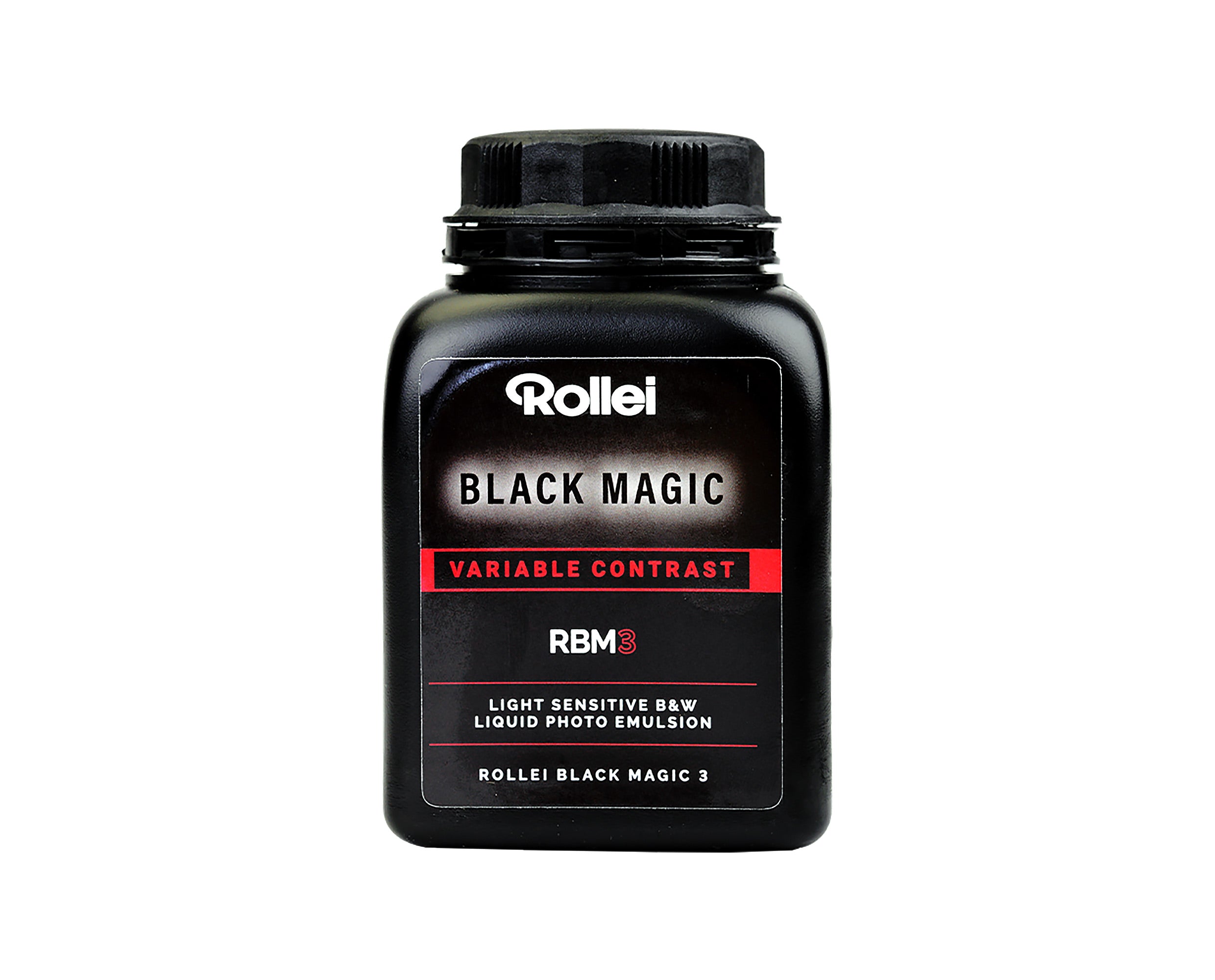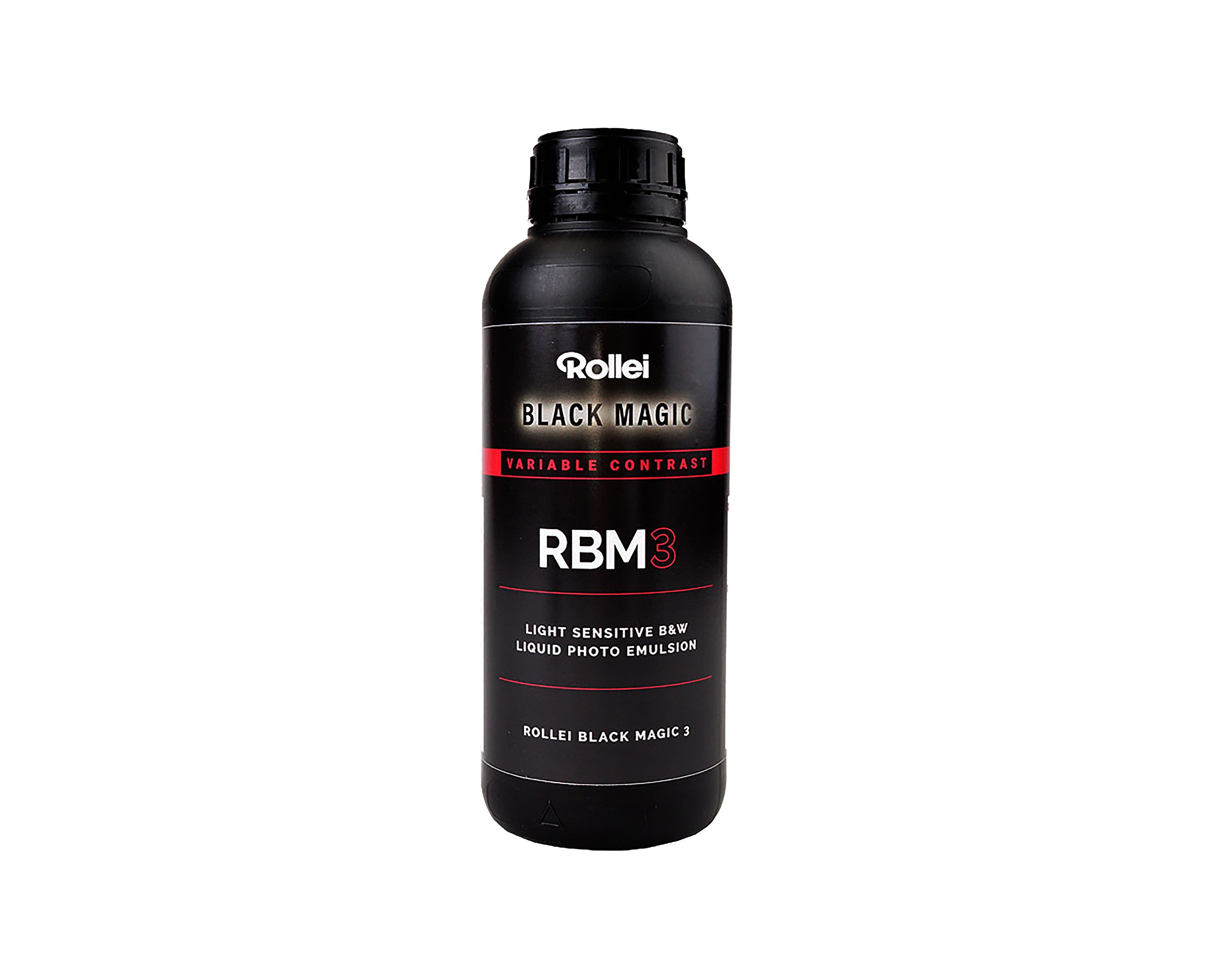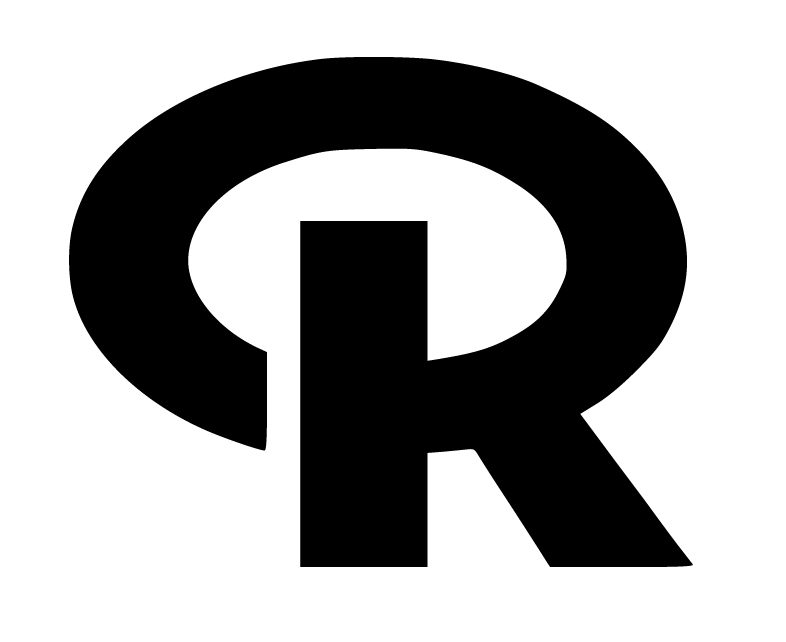

Rollei Black Magic Fotoemulsion Gradation variabel
Couldn't load pickup availability
Pickup available at Brookstieg 4
Usually ready in 24 hoursRollei Black Magic Fotoemulsion – Gradation variabel
Rollei Black Magic ist eine hochwertige Schwarzweiß-Fotoemulsion auf Silbergelatinebasis zur Herstellung individuell beschichteter fotografischer Oberflächen. Die Variante mit variabler Gradation ermöglicht eine gezielte Steuerung des Kontrasts – ideal für kreative oder experimentelle Anwendungen in der Fine-Art-Fotografie, alternativen Drucktechniken oder im Edeldruckbereich.
Die Emulsion lässt sich auf unterschiedlichste Trägermaterialien auftragen, z.B. Papier, Leinwand, Holz, Glas, Metall, Keramik oder Textilien. Nach dem Trocknen wird sie wie klassisches Fotopapier belichtet, entwickelt, fixiert und gewässert.
Dank ihrer Multigrade-Funktionalität lässt sich der Kontrast gezielt über gängige Gradationsfilter oder Farbkopfvergrößerer steuern – vergleichbar mit modernen variabel kontrastierenden Baryt- oder PE-Papieren. So kann das Druckergebnis optimal an das verwendete Negativ angepasst werden.
Hinweis zur Lichtempfindlichkeit:
Die lichtempfindliche Emulsion reagiert deutlich langsamer als Fotofilm – in der Praxis liegt die Empfindlichkeit typischerweise im Bereich von ISO 1 bis 3. Für Anwender bedeutet das: längere Belichtungszeiten sind üblich und ermöglichen eine besonders feinfühlige Steuerung der Bildwirkung.
Gerade bei starken Lichtquellen oder großformatigen Projektionen bietet die niedrige Empfindlichkeit viel kreativen Spielraum und verhindert ungewollte Überbelichtungen. Eine kurze Testreihe zur Belichtungsermittlung ist empfehlenswert.
Eigenschaften:
- Variable Gradation – steuerbar über Multigrade-Filter oder Farbkopf
- Silbergelatineemulsion für individuelle Bildträger
- Auftrag auf Papier, Holz, Glas, Leinwand, Metall, Keramik u.v.m.
- Auftrag per Pinsel, Rakel oder Gießtechnik
- Verarbeitung mit Standard-Schwarzweißchemikalien
- Vor Gebrauch auf ca. 35°C erwärmen
- Empfindlichkeit ca. ISO 1–3 (träger- und verarbeitungsabhängig)
- Ergiebigkeit abhängig von Material und Auftragsdicke
Verfügbare Größen:
- 300ml – ideal für Tests, kleinere Serien und Workshops
- 1000ml – für umfangreiche Anwendungen oder Serienprojekte
Pairs well with

Rollei Black Magic Fotoemulsion Gradation variabel
If you have any questions, we're happy to assist you!
You can contact us anytime – we usually reply within 1–2 business days.
-
Customer Service
Not sure about a product or have a specific question?
Just send us an email at hello@rolleianalog.com – we’re happy to help.
Or give us a call at +49 (0)40 23700 888 (Mon–Fri, 9:00 AM – 4:00 PM CET). -
Shipping Information
Shipping costs are calculated live in your cart based on your delivery address and selected shipping method.
For full details on delivery times, carriers, and international shipping, please refer to our Shipping Information page. -
International Shipping
We ship worldwide! If you're ordering from abroad and have questions about delivery, customs, or returns – feel free to get in touch with us.
FAQs
What do I need to develop black-and-white film?
For classic black-and-white film development, you need three baths:
Developer – makes the exposed image visible
Stop bath – stops the development process
Fixer – stabilizes the image and makes it light-resistant
With the Rollei Film Chemistry Kit, you get all three components in one perfectly matched set:
- Rollei RSG = developer
- Rollei RCS = stop bath (citrate-based, low odor)
- Rollei RXA = universal fixer
A compact solution for everyone who wants to develop black-and-white film at home – easy to use and precise in results.
Which chemistry is suitable for color film?
Color films require special development processes. For color negative film, this is the C-41 process.
The Rollei Colorchem C-41 Kit contains all essential components – color developer, bleach-fix (blix), and stabilizer – precisely balanced for safe processing at 38 °C. It delivers color-accurate negatives with fine grain and good longevity.
Note: Slide films (reversal films) require a different process – the E-6 process, which is more complex and not compatible with C-41.
How long do photo chemicals last?
It depends on the type of chemical, how it’s stored, and whether it’s been opened:
- Unopened concentrates: usually last 1–2 years if kept in a cool, dark place
- Opened concentrates: can last a few weeks to several months, depending on air exposure and storage
- Mixed working solutions: are typically good for a few days to a few weeks
Pro tip: If it smells off, changes color, or shows sediment – it’s probably time to toss it. For maximum shelf life, always store your chemicals airtight, cool, and away from light.
Can I reuse photo chemistry?
Yes, many photo chemicals can be reused – especially fixers, stop baths, and some developers.
The exact number of uses depends on the type of product, dilution, and volume of material processed.
Fixers can even be regenerated – for example, by adding fresh concentrate or a dedicated replenisher.
This is especially worthwhile if you're processing frequently and want to maintain consistent performance over time.
With developers, regeneration is more difficult: many are sensitive to oxidation and lose activity with each use.
A simple top-up usually isn’t enough – fresh working solutions are generally the more reliable choice.
Stop baths are typically replaced once the pH level shifts (e.g., when a color indicator changes, as in citrate-based stops).
Pro tip: If you process regularly, it’s helpful to track your usage (e.g., number of rolls or prints) to know when to refresh or regenerate your chemistry.
How do I properly dispose of used photo chemicals?
Photo chemicals should never be poured down the drain or thrown in the trash!
They contain substances that can harm the environment – especially fixer, which may contain residual silver. Used chemistry should be taken to a hazardous waste collection site or local recycling center. In some regions, labs or photo retailers also offer disposal services.
Pro tip: For small quantities, collect the chemicals in tightly sealed and clearly labeled containers and dispose of them all at once. Always follow your local regulations for disposing of photographic and lab chemicals.

